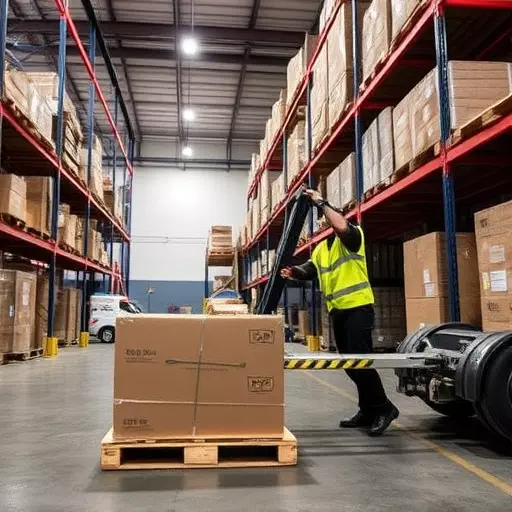In Holland, Ohio’s competitive logistics sector, prioritizing ergonomics is crucial for efficient and secure manual unloading processes. This involves staff training in safe lifting techniques, proper posture, and utilizing aids to reduce strain. Optimizing warehouse layouts, employing specialized equipment, and implementing effective loading/unloading protocols enhance worker safety and productivity. Focused strategies for loading and unloading services Holland Ohio reduce injury risks and operational inefficiencies. Advanced warehouse loading techniques and unloading safety protocols are vital for meeting e-commerce demands, protecting workers, and enhancing time/resource efficiency. Case studies show positive results from integrating ergonomics, leading to fewer musculoskeletal disorders and workplace injuries. Future trends include automation, robotics, AI, smart warehouse management systems, and ergonomic equipment.
“In the world of logistics, efficient and safe manual unloading is paramount for warehouse operations. This article explores the art and science of ergonomics in loading and unloading services Holland, Ohio, a bustling hub of distribution. From understanding the fundamentals of ergonomics to implementing best practices, we delve into techniques that enhance productivity while prioritizing safety. Discover innovative solutions, real-world case studies, and future trends revolutionizing warehouse logistics, ensuring a safer and more productive work environment.”
- Understanding Ergonomics: The Basics of Manual Unloading
- Warehouse Loading Techniques for Efficient Operations in Holland, Ohio
- Safety First: Essential Unloading Safety Protocols to Prevent Injuries
- Ergonomic Tools and Equipment for Improved Manual Unloading
- Best Practices for Maintaining a Safe and Productive Unloading Environment
- Case Studies: Successful Implementation of Ergonomics in Local Loading and Unloading Services
- The Future of Unloading: Innovations and Trends in Warehouse Logistics
Understanding Ergonomics: The Basics of Manual Unloading

In the world of logistics and warehousing, understanding ergonomics is paramount, especially when it comes to manual unloading processes in Holland, Ohio. Ergonomics focuses on optimizing work environments and tasks to ensure comfort, safety, and efficiency for workers. For loading and unloading services, this means employing techniques that minimize physical strain and reduce the risk of injuries associated with repetitive lifting and handling of goods. By implementing proper warehouse loading techniques and unloading safety protocols, businesses can create a safer and more productive work environment.
Manual unloading often involves heavy lifting and tight spaces, making it crucial to consider ergonomic principles. Warehouse staff should be trained in safe lifting practices, including proper posture, use of lifting aids, and efficient movement patterns. Additionally, optimizing the layout of loading and unloading areas, as well as utilizing specialized equipment when possible, can greatly enhance worker safety and efficiency during these critical operations.
Warehouse Loading Techniques for Efficient Operations in Holland, Ohio

In the efficient operations landscape of Holland, Ohio, advanced warehouse loading techniques play a pivotal role in enhancing productivity and ensuring the safety of manual unloading processes. Specialized loading and unloading services have become indispensable, particularly in the face of rapidly growing e-commerce demands. By implementing strategic approaches, these services streamline operations within the confines of the warehouse.
One key focus is adhering to stringent unloading safety protocols. This involves meticulously organizing pallets and goods to facilitate swift and secure removal from vehicles. Additionally, leveraging appropriate equipment, such as forklifts and pallet jacks, is crucial for minimizing manual labor strain. Such techniques not only reduce injury risks but also optimize time and resource utilization, making them essential for successful warehouse management in Holland, Ohio.
Safety First: Essential Unloading Safety Protocols to Prevent Injuries

In the world of logistics, manual unloading is a critical process that requires meticulous attention to safety. For those providing loading and unloading services in Holland, Ohio, adopting robust safety protocols is not just advisable but essential. Warehouse workers face physical demands and potential hazards during unloading operations, making it imperative to prioritize injury prevention. From tripping hazards to heavy load management, every step of the unloading process must be carefully navigated.
Implementing effective unloading safety protocols involves a combination of proper training, suitable equipment, and proactive risk assessment. Warehouse managers should ensure that employees are well-versed in safe lifting techniques, the correct use of handtrucks or forklifts (where applicable), and how to recognize and mitigate potential dangers. These measures not only safeguard workers but also enhance overall efficiency in loading and unloading services.
Ergonomic Tools and Equipment for Improved Manual Unloading

In the realm of loading and unloading services in Holland, Ohio, adopting ergonomic tools and equipment can significantly enhance efficiency while prioritizing worker safety. Modern warehouse loading techniques often involve manual labor, making it crucial to implement practices that reduce strain on employees’ bodies. One key aspect is utilizing specialized equipment designed with ergonomics in mind—tools that cater to the natural movements of the human body. For instance, adjustable height platforms and ergonomically aligned trolleys can facilitate efficient material handling while minimizing the risk of musculoskeletal disorders.
By investing in these ergonomic solutions, warehouse managers can ensure compliance with unloading safety protocols. Proper equipment usage not only boosts worker satisfaction but also reduces the potential for accidents. Additionally, ergonomic tools often feature innovative designs that simplify complex tasks, allowing workers to handle heavier loads without exerting excessive force. This is particularly vital for warehouses handling bulk goods, where efficient and safe unloading is a top priority.
Best Practices for Maintaining a Safe and Productive Unloading Environment

Maintaining a safe and productive unloading environment is paramount for any warehouse or logistics operation. Implementing best practices ensures that employees can work efficiently while minimizing the risk of injuries. At the core, proper training is essential. All staff involved in loading and unloading services in Holland, Ohio, should be thoroughly trained on optimal techniques, equipment use, and safety protocols. This includes understanding the weight limits of pallets, correct lifting methods, and how to safely operate forklifts or other heavy machinery.
Regular inspections are another critical component. Warehouses should conduct routine checks of their loading and unloading areas to identify potential hazards. This involves assessing floor surfaces for slip-and-fall risks, ensuring proper lighting to avoid accidents, and verifying that safety equipment like handrails and protective barriers are in place and well-maintained. Additionally, keeping the workspace organized and clutter-free significantly reduces tripping hazards and makes it easier for workers to navigate, thereby enhancing productivity and overall safety during unloading operations.
Case Studies: Successful Implementation of Ergonomics in Local Loading and Unloading Services

In recent years, several case studies have demonstrated the successful integration of ergonomics into loading and unloading services in Holland, Ohio. Local businesses have adopted innovative warehouse loading techniques, focusing on improving efficiency while prioritizing employee safety. One notable example involves a mid-sized distribution center that implemented ergonomic lifting aids and optimized workspace design. These changes significantly reduced the risk of musculoskeletal disorders among workers engaged in frequent heavy lifting and repetitive motions.
Additionally, stringent unloading safety protocols have been embraced, ensuring that all personnel are adequately trained in proper handling techniques. This proactive approach has led to a notable decrease in workplace injuries and an increase in overall job satisfaction. The implementation of ergonomic principles has not only enhanced the well-being of employees but also contributed to improved operational productivity, underscoring the mutual benefits of prioritizing worker health and safety in loading and unloading services.
The Future of Unloading: Innovations and Trends in Warehouse Logistics

The future of unloading is here, driven by innovation in warehouse logistics across the globe and a growing focus on efficiency and worker safety, particularly in high-volume operations like those seen in Holland, Ohio. Advanced technologies such as automation, robotics, and AI are transforming traditional loading and unloading processes. These innovations aim to streamline operations, reduce errors, and minimise the physical strain on workers. For instance, automated guided vehicles (AGVs) can efficiently transport goods within warehouses, while robotic arms enhance unloading speed and accuracy.
Trends point towards smarter, data-driven warehouse management systems that optimise loading and unloading sequences. These systems leverage real-time data to predict demand, prioritise tasks, and allocate resources effectively. Additionally, there’s a growing emphasis on unloading safety protocols to prevent workplace injuries. This includes the adoption of ergonomic equipment designed to reduce physical demands on workers during heavy lifting and repetitive tasks, thereby enhancing overall job satisfaction and productivity in warehouse environments.


